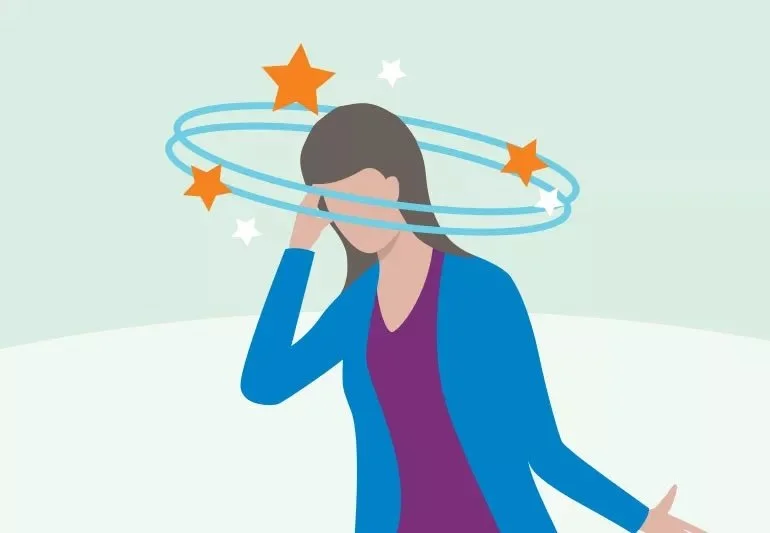Vertigo? How About, Verti-NO!
By: Kelsie Mazur, DPT
This week's blog post is super important to me as a doctor of physical therapy. We are talking about Vertigo. Vertigo is a blanket term that people use for feeling dizzy, off balance, nauseous with or positional changes, or like the room is spinning. Seeing a doctor of physical therapy is one of the best treatment options for all types of vertigo. Physical Therapists specialize in evaluating and treating balance disorders, including various forms of vertigo. We provide personalized assessments to determine the underlying cause of your dizziness and develop a tailored treatment plan. Through specialized maneuvers, exercises and education, physical therapy can help reduce symptoms, improve balance, enhance overall quality of life, and 100% cure certain types of vertigo… that’s right, 100%!
While there are many different forms of vertigo, each with its own causes and characteristics, (I can get into the weeds with describing the many different types and causes of vertigo) because the nervous system and brain are very complicated, for sakes of this blog post, we’re focusing on a specific and very common type called “BPPV”, or Benign Paroxysmal Positional Vertigo. BPPV is particularly well-known for causing brief episodes of dizziness triggered by changes in head position. If you’ve ever felt like the room is spinning when you move your head a certain way, or you get up from lying down, or simply lying down in bed, you might be familiar with this condition, and/or have been diagnosed with BPPV.
What is BPPV?
BPPV is a type of vertigo that occurs when tiny calcium crystals in your inner ear become dislodged and start floating in the wrong places. These crystals (known as otoconia) help your body maintain balance by sending signals to your brain about your head position. When they get out of place, they can cause false signals, leading to that dizzy, spinning sensation—often triggered by changes in head position, like rolling over in bed or looking up.
The good news is that BPPV is common and can affect anyone, though it’s more prevalent in older adults. Some factors that might increase your risk include:
Age: As we get older, our inner ear structures can change.
Head trauma: A fall or blow to the head can dislodge those pesky crystals, for example: being rear-ended in a car accident.
Prolonged bed rest: Extended periods of inactivity can contribute.
Inner ear disorders: Conditions like Meniere’s disease or vestibular neuritis may increase your chances of experiencing BPPV.
Even if you’re young and active, it’s still possible to experience BPPV, so don’t brush off that dizzy feeling!
What can a Physical Therapist do? I thought a Neurologist was my best option…
Feelings of dizziness and/or feeling like you’re off-balance can be really scary. Sometimes people go to the ER, which can be inconclusive, leading them to be referred to a Neurologist for further testing. This sequence of events is very common, and is the safest route to figuring out why you’re dizzy. Sometimes neurologists or even the ER doctors, if you’ve been diagnosed with BPPV, will stop at prescribing you medication that isn’t always helpful. Medication is not always effective for treating vertigo because it often addresses the symptoms rather than the underlying cause. While medication can help alleviate dizziness or nausea in the short term, it may not provide a long-term solution, especially for conditions like BPPV, where the root issue involves displaced crystals in the inner ear. Additionally, some medications can have side effects that may worsen balance or lead to drowsiness, which is counterproductive for someone dealing with dizziness. I know this seems like a lot of info!! For effective management, it’s often better to pursue targeted treatments, like vestibular rehabilitation with a Physical Therapist, which addresses the specific causes of vertigo and helps improve balance and function.
Accurate Diagnosis: A Physical Therapist can perform specific tests to confirm that your dizziness is indeed due to BPPV and not something else. We can rule out other things to determine what is actually causing your dizziness.
Tailored Treatment: Physical Therapists use specialized body maneuvers and positions to help reposition those displaced crystals in your inner ear. These treatments can significantly reduce your symptoms and help you regain balance.
Education and Prevention: Your Physical Therapist will also provide strategies to manage your symptoms and prevent future episodes. They can teach you how to move safely and avoid triggers, making you feel more confident in your daily activities.
Holistic Approach: Beyond just treating the symptoms, Physical Therapists can help improve your overall balance and coordination with tailored exercises, ensuring that you feel stable and secure in all aspects of your life.
BPPV and all other types of vertigo or neuro conditions can be frustrating, but the good news is that help is available! If you or someone you know is experiencing vertigo, don’t hesitate to reach out to me at Wattage. I am here to help you regain your balance and get back to enjoying life without the spins!

